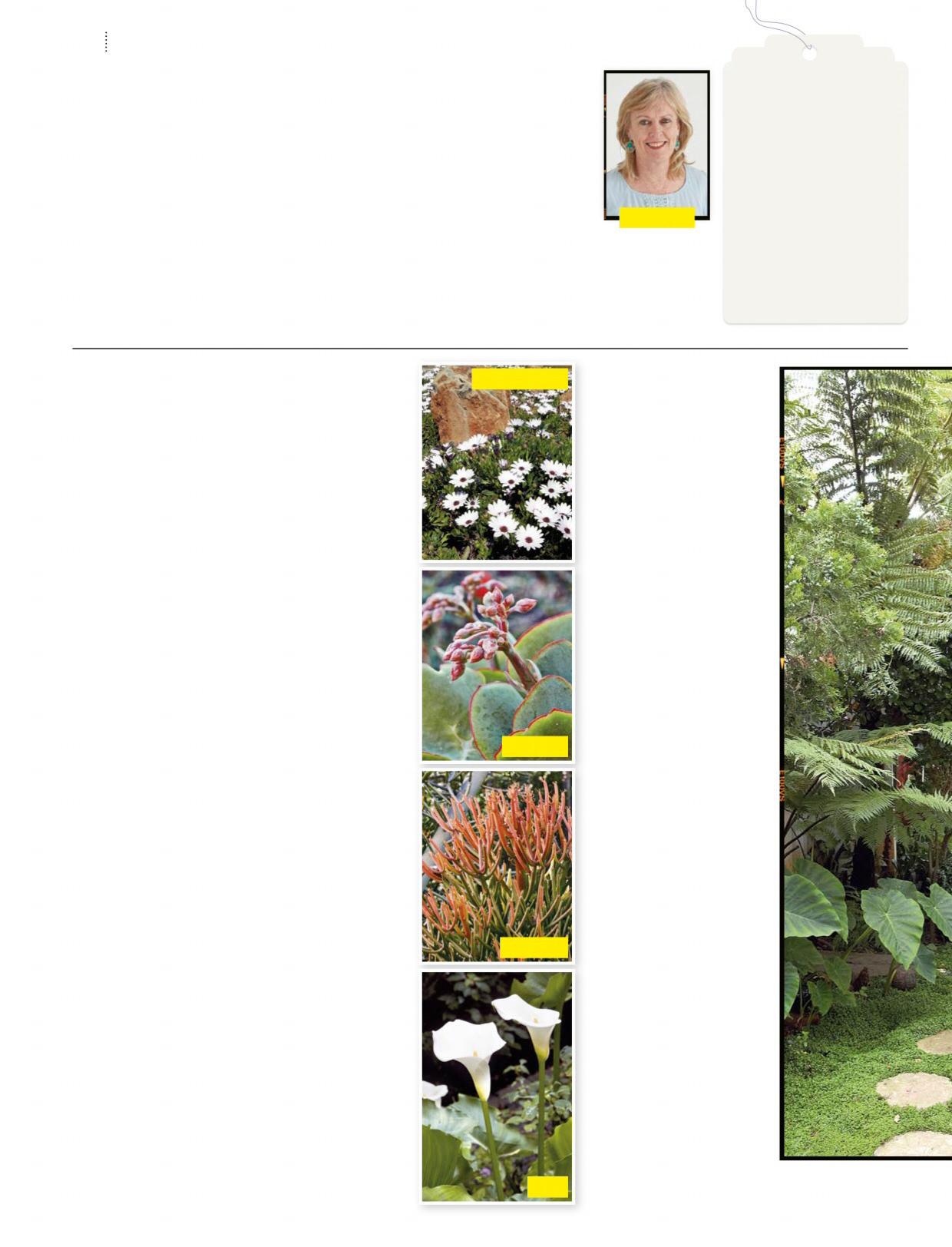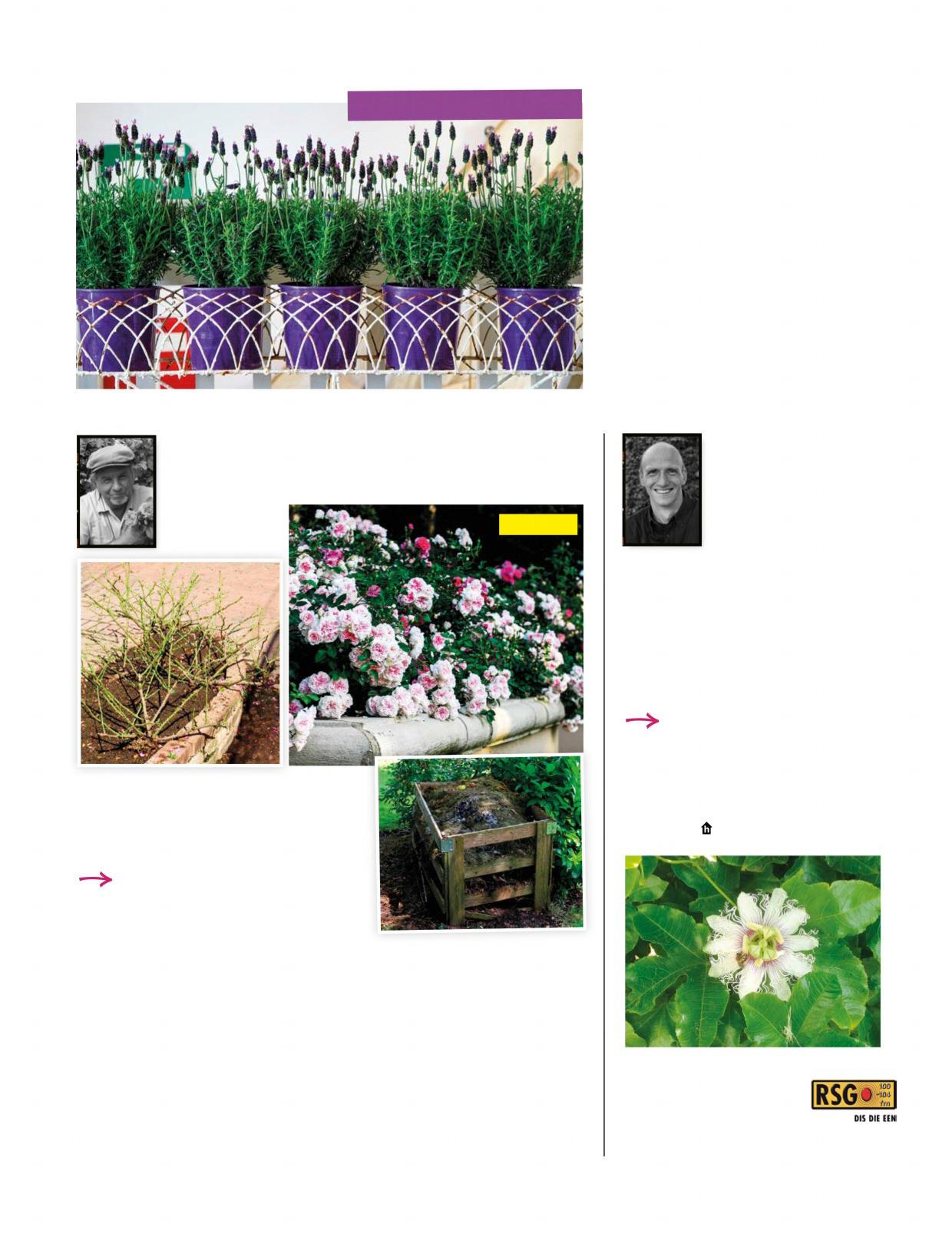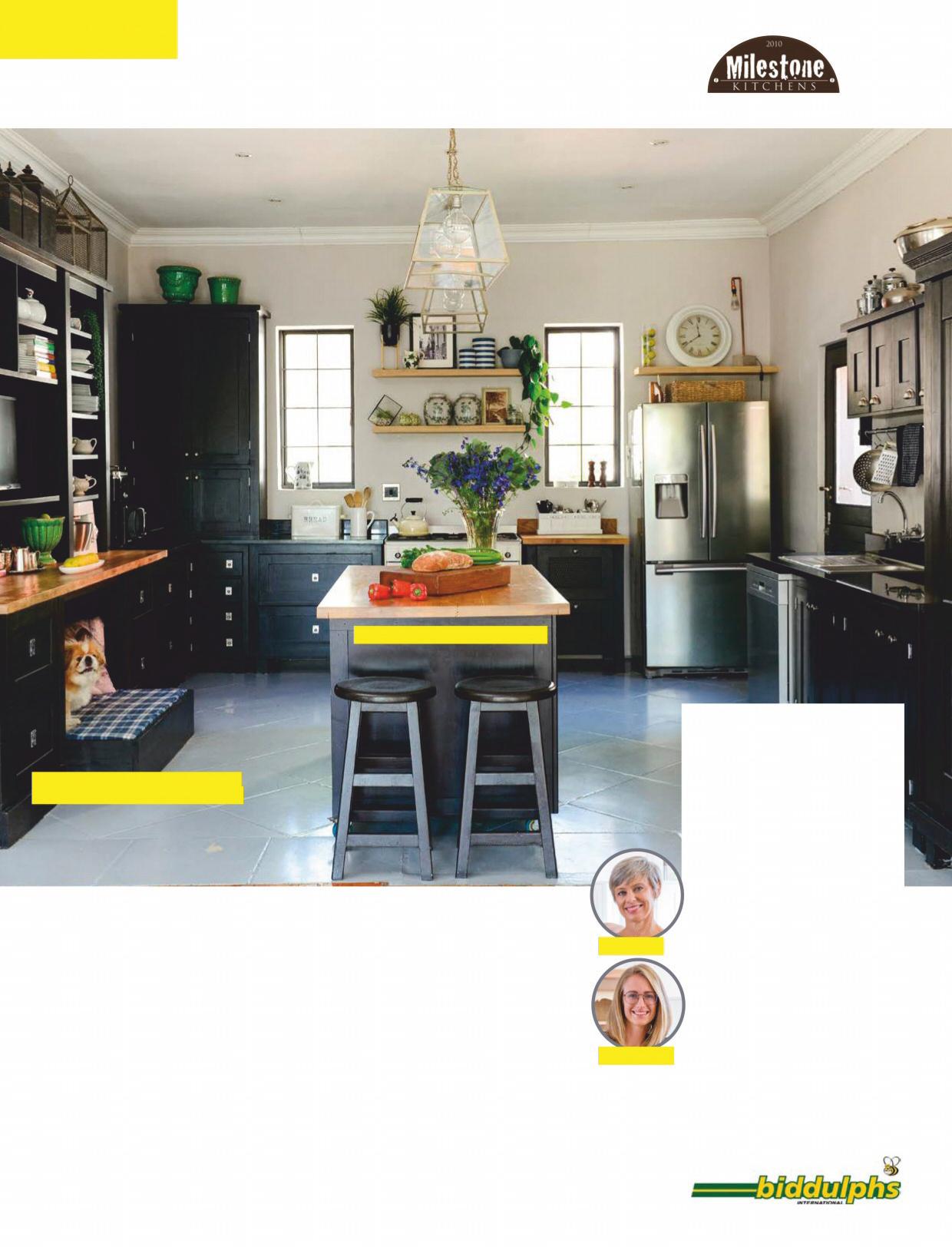
13 minute read
Send us your pet pics and WIN
from Cxfgytrcc
advice
Email your queries to pets@homemag.co.za
Advertisement
Animal antics
Compiled by Beatrice Moore-Nöthnagel
Take it outside!
Look there! Gatsby goes everywhere – even to the golf course with Dad! – Tayla-Jade Southby, Port Elizabeth Hot product If your dog is susceptible to tear stains caused by eye discharge, Vet’s Best Clean Eye Round Pads with soothing Aloe Vera (R75, shingavet.co.za) will help to reduce marks if used regularly.
Mieke points Willem in the right direction.
In on all the action
– Christine Schoeman, Oudtshoorn
Feline frisky Move over Lionel Messi; Molly is here! – Tamsyn Wiggill, Cape Town
Ready for adventure! Kitty is all set for some caravan action. –Mariette Swart, Brackenfell
Sno’ big deal Taz enjoys the snow in Switzerland before moving to SA. – Stephanie Hayman, Eston, KZN
On top of the world Charlie loves to explore. – Ryno Schoombee, Pretoria

WIN! Each owner whose pet is featured here wins an XL K9 Camper for dogs or a medium Cupcake for cats from Wagworld (wagworld.co.za), available at leading vet and pet shops. The K9 Camper is made from a heavy-duty waterproof canvas, discouraging the breeding of fleas and other mites, and while perfect for patios or kennels, it will also look attractive in your home’s interior. The Cupcake bed is a favourite among cats and smaller dog breeds, and it’s fully machine-washable. Send your pics (at least 2MB each) and contact details to pets@homemag.co.za – you could be a winner too! See competition rules on page 112.
Q&A
Make a difference Mary Nichols of Jo’burg writes I’ve read
various reports on how some pets have tested positive for Covid-19. Is this something we as pet owners should be concerned about? Gert Steyn, managing director of the South African Veterinary Association (SAVA), replies
Coronaviruses are a large family of viruses, some of which infect humans and certain animals such as cattle, cats, dogs, bats and camels. Canine and feline coronaviruses only infect animals; they don’t infect humans. But some of the coronaviruses that do infect animals, such as MERS Cov which infects camels, can infect people – but this is rare.
Although a dog in Hong Kong tested “weak positive” for Covid-19, it hasn’t shown any symptoms of the disease. It is, as yet, unconfirmed whether the “weak positive” result is due to the presence of the virus itself or if the dog actually contracted the disease, as it hasn’t shown any antibody response to date. There is, thus, still no evidence to suggest that any animals – including pets, livestock, or wildlife – might be a source of Covid-19 infection at this time.
Besides direct exposure after the droplets of an infected individual have been breathed in, transmission via touching a contaminated surface or object (pets) and then touching the mouth, nose, or possibly eyes is feasible. Smooth nonporous surfaces (e.g. countertops, doorknobs) transmit viruses better than porous materials (e.g. pet fur) as porous materials absorb and trap the virus, making it harder to contract through touch.
However, because all animals can carry various pathogens that can be transmitted to people, the following habits should be practised: • Wash your hands after handling animals, their food, waste or supplies. • Clean up after pets properly. • Seek advice from your local vet if you have any concerns about the health of your pet.
How to protect pets if you have Covid-19:
If you have Covid-19, or suspect you do, practise social distancing from pets as you would with humans. If possible, have another member of your household care for your animals while you’re sick. Avoid contact with your pet, including petting and being licked. If you have to care for your pet while you’re sick, wash your hands before and after you interact with them. REMEMBER Don’t use sanitiser on your pet and don’t touch them just after you’ve used any as it can be harmful. CONTACT sava.co.za
advice
Send garden info and queries to gardens@homemag.co.za.
Gardening notebook
Gillian Eva
Create a new pathway in your garden this month, or check existing ones for uneven surfaces and repair them now.
Compiled by Gillian Eva • Photographs Francois Oberholster and supplied
Osteospermum
narrow and winding, up hills and down dales, through grasslands, whispering woods and alongside meandering streams made by animals searching for food and water and by the feet of early man as he hunted and gathered wood. Garden paths Paths in gardens, as in life, are trails of discovery; they are walkways that guide visitors from one area to another, sometimes swiftly and other times at a more leisurely pace, creating a particular mood by their direction and by their shape. Paths should always lead to a destination. and to utility areas such as a laundry or garage. Formal gardens with year-round structure have direct paths, as do formal herb gardens with beds dissected by paths.
There is a sense of anticipation and mystery when all is not revealed at once –of a secret world, a private space, a hideaway. A curving path slows down progress and makes the journey more interesting, inviting the visitor to discover what lies around each either side will slow down progress. A path that disappears around a shrub or hedge encourages exploration and stops people and pets from taking shortcuts. A meandering path through a wildflower meadow or woodland walk creates a feeling of mystery, adventure and romance.
Japanese gardeners are masters of suggestion, concealing as much as they reveal in their landscapes. They encourage contemplation with the careful placement of plants, water and rocks and use curving paths to conceal parts of the garden.
WHY DO WE PRUNE PLANTS?
Pruning is done to encourage a good shape and a healthy plant, and to improve the quality of fruit or flowers. In mild winter gardens, prune in the second half of July but in cold gardens, wait until the beginning of August to avoid possible frost damage to new
Walk this way
The original paths of ancient times were

A straight path is used to reveal the shortest possible route to an entrance, to a home office,
bend or curve.
A narrow path with colourful flower borders on
emerging growth.
Cotyledon
Euphorbia
[RAIN PATHS ] Hugelkultur is a German word meaning mound or hill culture (culture here refers to growing things) where plants are grown on a man-made mound or small hill.
On a flat site, hugelkultur mounds will add highs and lows; the highs made by laying old logs where you want a mound, then covering the wood with leaves, soil and compost to about a metre in height.
By building these mounds, you create a path or swale (a shallow channel with gently sloping sides) that will direct rainwater from hard surfaces so that it is slowly absorbed into the soil and does not run off.
These swales also become habitats for a diverse range of plants. On mounds, grow Bulbine frutescens, Euphorbia tirucalli, Cotyledon orbiculata, Senecio mandraliscae and Aristida junciformis. For low areas, consider white arums, wild garlic, sedges, hostas and astilbes. On slopes, try Portulacaria afra ‘Nana’, osteospermum and arctotis.
In the vegetable garden, bush beans, bell peppers and onions can be grown on mounds; squashes and nasturtiums will thrive on slopes, and parsley and lettuce are both suitable for low areas.
Waterwise plant of the month Water smart
Flapjack plant
The flapjack plant ( Kalanchoe luciae) is also known in Afrikaans as meelplakkie because its foliage appears to be dusted with flour ( meel) which helps to reflect the sun and keeps the plant cool. This succulent forms a basal rosette of large rounded leaves that are greyish-green in colour with red margins. The flower head is tall with small tubular white flowers that are sweetly scented. Before the mother plant dies, she produces small plantlets that can be planted out. For the best leaf colour, grow in full sun in rock gardens and on rocky slopes.
We love succulents! Sedum rupestre ‘Angelina’

There are many different varieties of Sedums, also known as stonecrop. Low-growing varieties such as ‘Angelina’ make vigorous, quick-growing groundcovers and border plants, with lovely bright lime-yellow foliage. It has a spreading growth habit, up to 60cm wide, with short upright stems (20cm high) and spiky leaves that add texture to the garden. Clusters of small yellow flowers appear in midsummer, attracting butterflies. It is a heat- and drought-tolerant groundcover for dry, sunny slopes and lowmaintenance pavement gardens. How to grow Stonecrops tolerate semi-shade but do best in full sun, which brings out the foliage colour. They grow in poor to moderately fertile, well-drained soil. Reduce watering once established and keep the soil dry in winter. Too much shade dulls the leaf colour. Clip to keep in shape. Garden uses Use for texture, contrast and brightness in a garden bed, especially as a contrast plant with dark or burgundy-leafed plants. It is particularly effective when planted in swathes to create a river of colour. It is also very eye-catching when used to cascade over rockeries and walls, as well as in containers on sunny patios or decks. Did you know? Stonecrops are cold-hardy; their leaves take on a reddish hue in winter. Good to know They do not tolerate foot traffic because the fleshy stems are fragile and are easily broken. Although they spread quickly, they are not invasive and respond to clipping or they can easily be pulled out. CONTACT ballstraathof.co.za
advice
Grow your own!
Growth in the veggie garden slows down in July, leaving ample time to plan for spring and summer sowing. Towards the end of the month, kickstart summer fruiting crops by sowing seed indoors in seed trays or pots, under warm, controlled conditions. By the end of September, seedlings will be ready for planting out.
Cabbage seedlings
How to germinate seed indoors
• Place seed trays or pots in a warm area near a north-facing window or heat them from the bottom up by putting them on a hot tray (on newspaper) or on an electric blanket on its lowest setting. • Create a moist microclimate by covering the seed trays with clingfilm. • If trays indoors do not receive enough light, take them out during the day and bring indoors at night. • After germination, move the seed trays closer to a sunny window during the day (but move them away at night when it gets cold). You can also take them outside to a warm sheltered area and bring them back indoors at night.
Planning tips
• Choose veggies that your family will eat. • Set up a sowing schedule, including
Brussels sprouts
succession planting (sow seeds at different intervals so the plants don’t all mature at the same time) and make a note of estimated harvest dates. • Factor the first and last frost dates into your planning. [ KITCHEN GARDEN TASKS FOR JULY ] • Water early so that plants can dry out by nightfall. Vegetables in containers need watering once or twice a week. • Boost broccoli, Brussels sprouts, cabbage and kale with a nitrogen-rich liquid fertiliser. • Stake broad beans and Brussels sprouts. • In regions that don’t get rain in winter, moisten (but do not soak) the compost heap. • Dig manure into empty beds so that it can break down before planting in August.

What to sow now
Summer rainfall areas Start sowing garden peas in cooler areas and lettuce, parsnip, radish, Swiss chard, tomatoes (indoors), and turnips in less frosty areas. ‘Above ground’ crops such as cabbage, squash, leafy greens, tomatoes, brinjals, peppers and chillies can be sown in seed trays indoors. Winter rainfall areas Sow the same fruiting vegetables as for summer rainfall regions indoors, plus beetroot, celery, garden peas, radishes, and turnips in situ (directly in the kitchen garden bed).
Lowveld and KwaZulu-Natal coast
This is prime sowing time for beetroot, beans, brinjals, chillies, carrots, cucumber, mealies, melons, squash, pumpkin, radishes, Swiss chard and tomatoes.
Indoor plant of the month
Ask Ludwig

‘My Granny’ Light trimming of ‘My Granny’.
Groundcover roses Marion de Waal of Germiston writes
I have a border of ‘My Granny’ roses. Do I need to prune them and how do I go about it?
Ludwig replies We classify ‘My Granny’ roses as groundcover roses, which are generally low-growing spreading shrubs with arching stems Add compost around roses. that carry clusters of flowers. With all roses that grow like this (the other ‘Granny’ roses, Sunsation range, Flower Carpet, ‘Adele Searll’, and Fairy roses) the easiest way to prune them is to give them a good clipping with hedge shears and remove some or all of the two-year-old wood.
Pull off all, or as many leaves as possible, because they can harbour pests and diseases. Regenerating the soil after pruning is just as important as pruning if the roses are to grow well in the coming season. Because of the spreading branches, even after pruning, digging over the soil is difficult. An easier way is to spread compost and Vigorosa over the area and spike it in with a fork. This allows the compost to fall into the holes made by the fork, which improves aeration and water-holding capacity at root level. Water well afterwards. In most areas, the best time to prune is from mid-July to early August, but later in very cold areas. CONTACT ludwigsroses.co.za
advice
Lavandula stoechas
Lavandula stoechas is a spring-flowering lavender with strongly aromatic foliage that adds fragrance and beauty to the home. It flowers profusely with bracts on top of each bloom, resembling bunny ears or the open wings of a butterfly. If grown indoors, it needs bright light and can take some morning sun. Let the soil dry out moderately between watering. Snip off spent flowers to encourage more. In warm, bright conditions, such as a patio or living area, it may bloom for up to three months. After flowering, plants can be lightly trimmed and planted in the garden in full sun; make sure the soil drains well. CONTACT plantimex.co.za
Ask JJ
Lack of fruit Wimpie van der Walt of Bredasdorp writes Why does our granadilla creeper
bear masses of flowers but no fruit? It’s always full of bees but the flowers fall off after a day. It has not borne a single fruit this season.
JJ replies There are two types of granadilla: an ornamental one and a fruiting one. If you have lots of bees pollinating the flowers, it is probably an ornamental variety. Enjoy it for its flowers, and plant a fruitbearing variety next to it if you’d like to harvest fruit.
Listen to JJ’s gardening tips and tricks on Derrich Gardner’s show Brekfis met Derrich at 07:40 every Saturday on RSG.
crossword #143
Compiled by Gerda Engelbrecht
WIN! One of eight NB Publishers books worth R290 could be yours. Maggie: My Life in the Camp by Maggie Jooste is a remarkable first-hand account of a teenage girl’s experiences during the Anglo-Boer War. Margaretha (Maggie) Jooste was only 13 years old when the Anglo-Boer War broke out and her life was irrevocably changed. After months of house arrest in their Heidelberg (Transvaal) home, she, her mother and younger siblings were sent away to concentration camps in Natal. There they experienced hunger, deprivation and loss, but also surprising acts of kindness from British guards. This very personal account is a story of hardships, but also one of humanity and friendships over enemy lines. A deeply moving, but also heartbreaking, true story. The first eight readers
whose correctly completed crosswords are drawn will each win a copy of Maggie: My Life in the Camp worth R290.

Send the completed crossword, and your details, to Home Crossword #143, PO Box 1802, Cape Town, or scan in your completed crossword
and email it to competition@homemag.co.za to reach us by 31 July 2020. See our competition rules on page 112.







